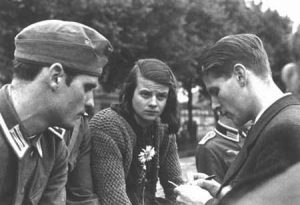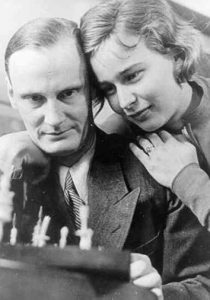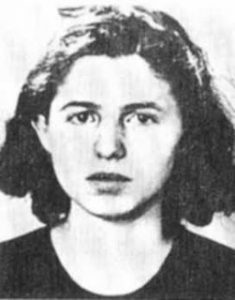
Most people – when they think of German women’s attitudes towards Adolf Hitler – imagine star-struck blonde Frauleins with their hands stretched high in the Nazi salute.
Some German women were even said to eat the gravel upon which Hitler trod.
There were some German women who feared and hated the Nazi leader, however, and who risked their lives to resist his brutal dictatorship.
Sophie Scholl is probably the most famous. A university student in Munich, she and her brother and some friends set up the White Rose group in the summer of 1942. Together Hans Scholl and his friends Willi Graf and Christoph Probst spread anti-Nazi graffiti and wrote six political leaflets, which Sophie helped distribute in letter-boxes and through the mail. On 18 February 1943, Sophie and her brother took the sixth leaflet to the university to spread around the campus. A janitor grew suspicious and followed them, and so Sophie threw all the leaflets over a balcony. The siblings were caught and turned over to the Gestapo. Christoph was soon arrested too. After a mock-trial, they were all beheaded. Hans was 24, Christoph was 22, and Sophie was only 21.
Hans & Sophie Scholl, and Christoph Probst

In Berlin, another resistance group was secretly meeting to make plans to overthrow Hitler. Like the White Rose, they tried to express their horror and outrage at the Nazi regime through graffiti and leaflets. They also smuggled Jews and other political prisoners out of the country, gave food and clothing to those who were suffering, and collected evidence of atrocities.
This group was called The Red Orchestra by the Gestapo, who suspected them of selling State secrets to the Soviets and harbouring Russian spies. The group – who simply called themselves the Zirkel (meaning circle) – certainly did try to warn Stalin about Germany’s imminent invasion, though they received no payment for the risks they took. They also warned the US and Great Britain, only to have their approaches mistrusted and ignored.
The Zirkel was led by two couples - Harro and Libertas Schulze-Boysen and Arvid and Mildred Harnack - and so contemporary scholars often now call them the Schulze-Boysen/Harnack Group.
Harro was an officer in the Luftwaffe, and – after the war broek out - worked for Goring’s Reich Aviation Ministry in Berlin. Libertas was the daughter of one of Berlin’s most famous couturiers, Otto Ludwig Haas-Heye, and the granddaughter of Prince Philip of Eulenburg and Hertefeld, once an influential courtier at the imperial court of Kaiser Wilhelm II. She had worked for the MGM office in Berlin, but quit her job and went to work for Goebbels’ propaganda office in the hope of getting access to confidential information.
Arvid was a lawyer and economist who took up a position in the Reich Economic Ministry, while his American-born wife Mildred – previously a university lecturer and author – did translation work for various German publishers and newspapers.
The group’s primary aim was to gather and pass on military intelligence to the Allies, and so they lived double lives, working inside the Nazi death machine whilst trying to sabotage it from within.

Eventually the Gestapo broke the covert operation, and Harro, Libertas, Arvid, Mildred and many more were arrested and executed. Mildred holds the unhappy distinction of being the only American woman executed by the Third Reich.

Mildred Harnack
There were many other women in the Zirkel, such as the half-Jewish artist and photographer Elizabeth Schumacher, and Greta Kuckhoff, who was married to the playwright and dramaturge Adam Kuchoff. Cato Bontjes van Beek (aged 22) and Liane Berkowitz (aged 19) were the youngest of the group, both being executed by guillotine in 1943. (All these women feature as characters in my novel THE BEAST’S GARDEN.)
Also working in Berlin at the same time was a Jewish circle of friends generally known as the Baum Group, named for its leaders, Herbert and Marianne Baum. Most people in the group were young – aged in their twenties – and working as forced labour in Berlin’s armament factories.
Other members included Sala and Martin Kochmann, Heinz Birnbaum, Heinz and Marianne Joachim, Edith and Harry Cohan, Gerd and Hanni Meyer, and the sisters Hella and Alice Hirsch.

Hella Hirsch
The group worked to help the plight of the Berlin Jews, and sabotaged the weapons they were helping to build. They undertook bold graffiti campaigns, and then – in September 1942 - they attempted to blow up Goebbels’ anti-Soviet propaganda exhibit in Berlin, using materials stolen from the factories in which they worked. Only a small fire resulted, but the event was an embarrassment to the Propaganda Minister.
The defiant saboteurs were soon rounded up, tried and executed. Herbert Baum died in prison, with an official report of suicide. Sala Kochmann tried to fling herself from the windows of the Gestapo headquarters and broke her back. She was carried to her execution on a stretcher. Three of the young women – including Alice Hirsch who was only 19 – were spared the guillotine but were then sent to Auschwitz, where they were murdered. (The Baum Group also features in THE BEAST’S GARDEN).
Another interesting woman who did her best to resist Hitler was the Countess So'oa'emalelagi von Ballestrem-Solf, known as ‘Lagi’ to her friends. Her name is Samoan, given to her when she was born by her father, who was the Governor of samoa in the 1920s and early 1930s. Lagi and her mother Johanna Solf hid fugitive Jews in their house and helped them escape across the border into Switzerland. They also helped prisoners-of-war and smuggled letters and information out of Germany. A Gestapo spy infiltrated their circle and betrayed them. Most of their friends were executed, but Lagi and her mother remained in prison. After a bombing raid destroyed all the evidence, they were both released, but were so damaged in their health from their time in prison that both died a few years after the war.

Finally, no discussion of the resistance of German women would be complete without including the famous Rosenstrasse protest, one of the largest public displays against Hitler.
The event happened in early 1943. The Nazis were quickening their round-ups of Berlin Jews, with thousands being deported in horrific conditions to concentration camps.
Up until this point, Jewish men who had married a non-Jewish woman before the passing of the Nuremburg laws had been protected from the worst of the atrocities. However, Nazi authorities had decided to ignore earlier protestations of protection, and had arrested a large number of these men. They were locked inside a Jewish welfare office on Rosenstrasse.
Their wives went to protest their arrests, surrounding the building and refusing to leave even when soldiers threatened to fire into the crowd. For over a week, the women picketed the building, making it impossible to transfer the prisoners to the train station. Many threats were made, but the women did not back down and eventually the prisoners were released, including those that had already been sent to Auschwitz.

A moving set of sculptures in rose-coloured stone now marks the spot where German women faced up to machine-guns to try and save their loved ones.

